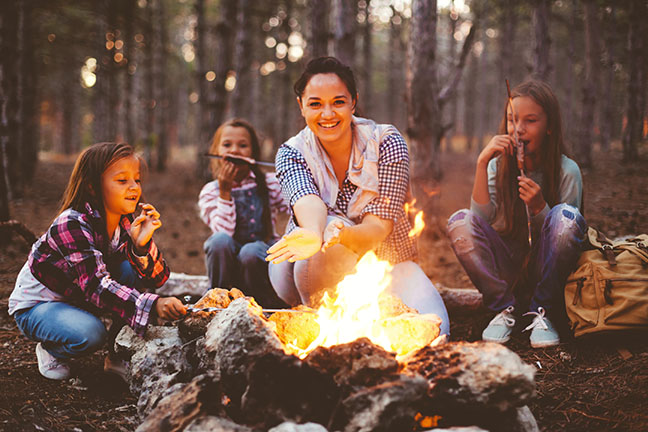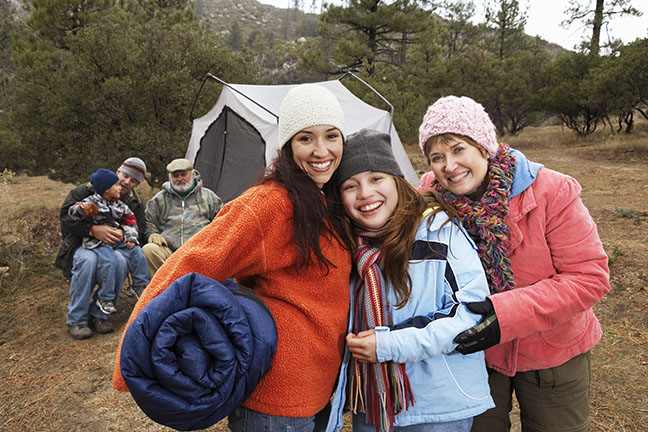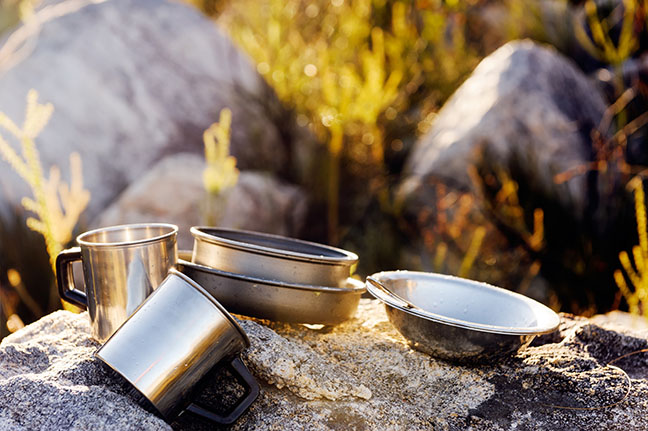
Fall is almost here which means the weather is finally cooling down. While fall is technically the off-season for camping, it comes with a lot of perks including less bugs, lower rates at campgrounds and cooler weather that pairs perfectly with comfort foods. This is the ideal time of year to pack up your gear and spend some quality time with Mother Nature. As an added perk, we’ve compiled a list of ways you can save money on your next camping adventure.

Transportation
The easiest way to save gas money is to camp close to home. Look up some camping options near you and save the gas money.
Having a hard time choosing between renting an RV or packing up the car and pitching a tent? If you want to camp on a budget, the best route is to pack a tent in a fuel efficient car and avoid the gas guzzling RV.
Take your friends along. It’s not only a more fun experience camping with your friends, it’s also a great way to save money by sharing some of the costs.

Location
If you’re a young family that is new to camping, your backyard may be every bit as exciting as a campground. Pitch a tent in the backyard, grab your sleeping bags and sip on some hot cocoa while adventuring right at home. The kids will have a blast.
Some of the more popular national parks charge an entrance fee up to $30 while others arecompletely free of charge. If you do some research ahead of time, you’ll find some less popular parks that don’t charge an entrance fee with scenery that is just as stunning. Plus, you won’t have to deal with the crowds that come with more visited parks.
If you have your heart set on one of the big national parks like Yellowstone, Yosemite or the Grand Canyon, there are free days throughout the year. Martin Luther King Jr. Day, President’s Day, Veterans Day Weekend and more. Plan ahead and you can enjoy the most popular national parks without paying – granted, you may be enjoying them with a plethora of other campers.
Are you an avid national park camper? Rather than paying the entrance fee per visit, it might be more economical to get an annual pass for $80. There are also discounts and free passes available. If you’re a current U.S. military member, you are offered a free annual pass. Do you have a soon to be 4th grader? For the duration of the school year and following summer, 4th graders get a free pass to the park. The National Park Service also offers free passes to volunteers who give 250 hours of service or more. If you’re a senior citizen, annual passes are only $10 or you can get a lifetime pass for $80. Here are all the details on National Park passes.

Supplies
What items do you have at home already? Before purchasing anything, take inventory of the camping supplies you have around your house. You may be surprised at the useful items you forgot you own. See our checklist below to see what you have at home and to make sure you don’t forget anything!
While name brand items may look nice, you’re not aiming to impress anyone in the wilderness. Save some major cash by purchasing items such as utensils, cups, pots and pans and even clothing at a second hand or discount store.
Camping gear is an expensive investment, so if you’re not someone who camps often, consider borrowing or even renting equipment instead. There’s no use in buying items that will only be used a handful of times. OutdoorsGeek has a lot of great rental options to fit whatever style of camping experience you want.
Plan your meals ahead of time so you don’t end up buying food at the supply store or going to the restaurant on site. Also, double and triple check to make sure you packed everything. Supply stores at campgrounds are convenient, but you pay for convenience. Make your list, check it twice and then check it again to make sure you don’t forget anything important. If you need some inspiration on camping meals, we’ve got some ideas.
Visit our Pinterest board with all kinds of other ways you can save on your next camping adventure.
Here’s a camping checklist
Campsite Gear:
Tent and all tent accessories (poles, stakes and instructions)
Tarp or cover for underneath your tent
Lanterns
Head Lantern
Flashlights
Batteries
Fuel
Bug Spray
Firewood
Chairs
Kitchen Items:
Cooler
Plates/cups
Utensils
Knife/Serving Spoons
Cutting board
Paper towels/napkins
Pots and pans
Wet wipes and/or Clorox wipes
Campfire grill grate
Roasting sticks
Stove
Ice (Blocks last longer than cubes)
Water/drinks
Corkscrew/bottle opener!!
Dish soap
Washcloth/sponge
Water
Container to wash dishes
Foil
Tablecloth
Grocery bags and trash bags
Coffee maker (pre-made cold brew coffee is a great alternative to camp coffee)
Sleeping Gear:
Sleeping Bag
Pillow
Sleeping Pads (for extra cushion)
Extra blankets/sheets
Air mattress (this is semi-glamping)
Clothing:
Daytime clothes
Pajamas/sleepwear
Clothes for rain
Swimming attire
Shoes – slip on/hiking/water/boots
Extra layers – sweaters, hats, coats, gloves
Toiletries:
Toilet paper
Soap
Toothbrush/toothpaste
First-aid kit
Sunscreen
Towels
Pet Supplies:
Food
Water
Water cooler
Food/water bowls
ID tags
Collar/leash
Long cable leash
Dog bed/blankets
Treats!
Toys
Dog waste bags
Other Stuff:
Repair kit for damage to camping gear
Bikes
Backpack
Map of camp area
Campsite reservation information